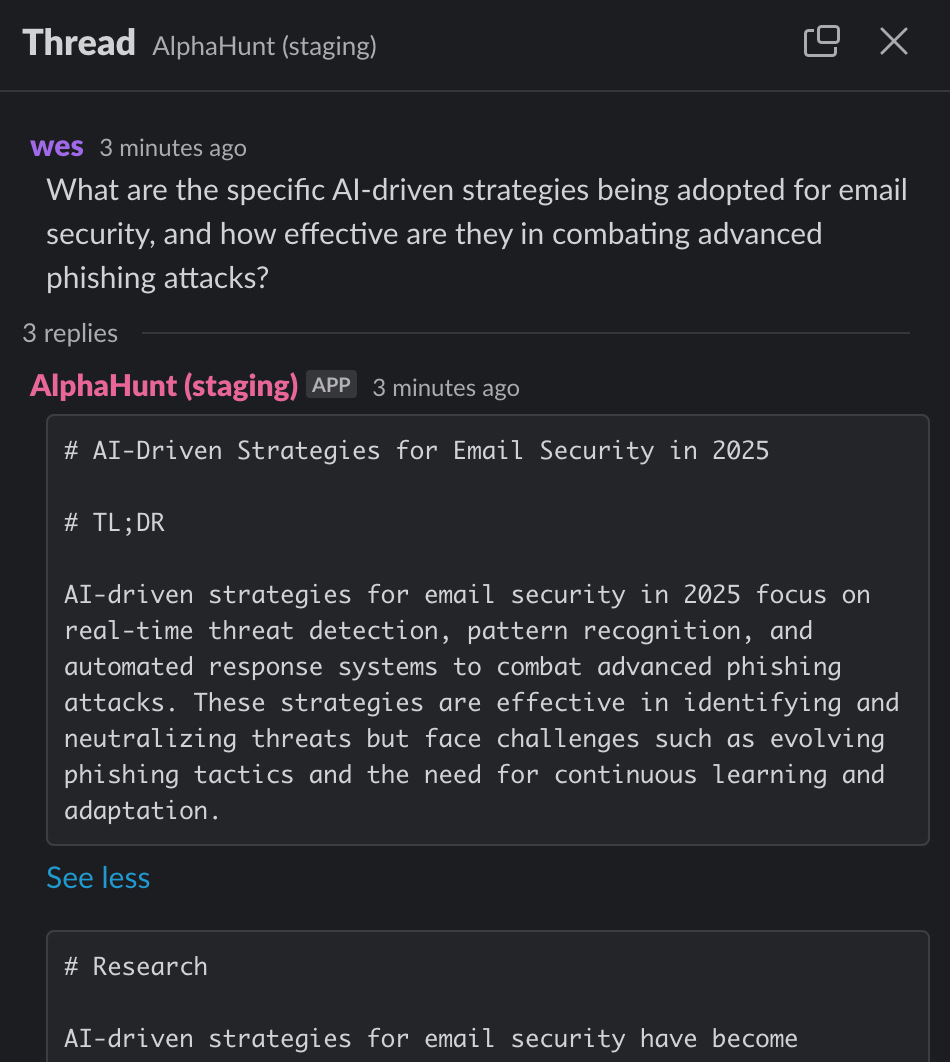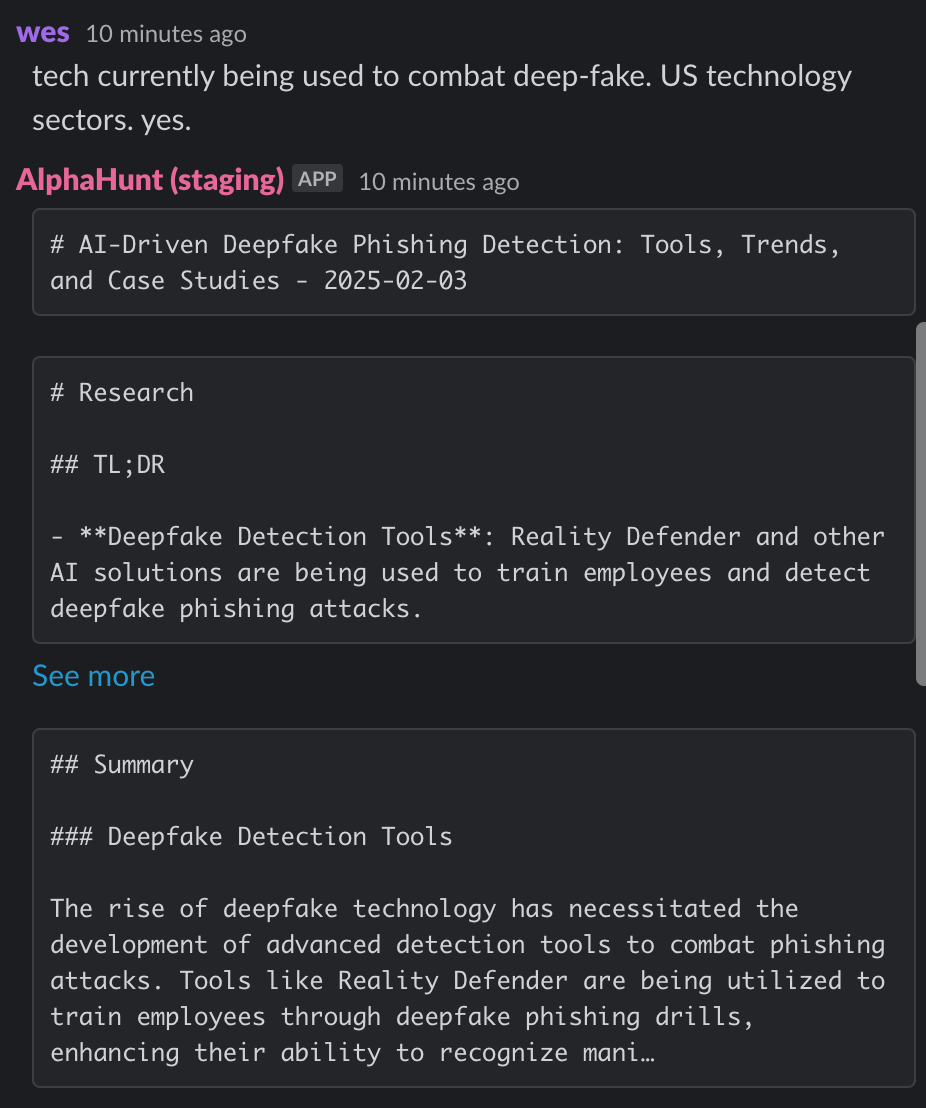AI-Driven Deepfake Phishing Detection: Tools, Trends, and Case Studies
The rise of deepfake technology has necessitated the development of advanced detection tools to combat phishing attacks. Tools like Reality Defender are being utilized to train employees through deepfake phishing drills, enhancing their ability to recognize manipulated content.




EDITOR'S NOTE: I'm testing the next generation of the AlphaHunt- the research goes a bit deeper, more directed and "peer" reviewed. The layout may still need some work... feedback welcome (just hit reply! :)
Thanks for taking the time to subscribe and read these, I hope they bring you some value!
Research
TL;DR
- Deepfake Detection Tools: Reality Defender and other AI solutions are being used to train employees and detect deepfake phishing attacks.
- Effectiveness: Reports indicate a significant rise in AI-driven phishing attacks, with deepfake fraud accounting for a large percentage of cases.
- Case Studies: Notable incidents include a $243,000 loss due to deepfake audio and a $25 million scam involving deepfake video.
- Recommendations: Implement AI detection tools, conduct regular training, and establish metrics for evaluating tool effectiveness.
- Forecast: Expect increased adoption of AI tools and enhanced training programs in the short term, with evolving detection technologies and regulatory scrutiny in the long term.
Summary
Deepfake Detection Tools
The rise of deepfake technology has necessitated the development of advanced detection tools to combat phishing attacks. Tools like Reality Defender are being utilized to train employees through deepfake phishing drills, enhancing their ability to recognize manipulated content. These tools employ sophisticated algorithms to analyze video and audio for signs of deepfake technology, providing a critical line of defense against these evolving threats.
Effectiveness and Metrics
The effectiveness of deepfake detection tools is underscored by reports from cybersecurity firms. For instance, Zscaler has noted a 60% increase in AI-driven phishing attacks, highlighting the growing threat landscape. Additionally, a study by Eftsure found that deepfake fraud accounted for 88% of all detected cases in 2023, emphasizing the need for robust detection measures. These statistics underscore the importance of implementing effective detection technologies and continuously evaluating their performance through metrics like precision and accuracy.
Case Studies and Examples
Real-world incidents illustrate the financial impact of deepfake phishing attacks. A UK company suffered a $243,000 loss due to a deepfake audio impersonating a CEO, while another case involved a finance professional being manipulated into wiring over $25 million. These examples highlight the sophistication of deepfake scams and the necessity for organizations to adopt comprehensive detection and prevention strategies.
Recommendations and Next Steps
Organizations are advised to implement AI-powered deepfake detection tools, such as those developed by Thales, and conduct regular training and simulations to educate employees about the risks. Establishing metrics for evaluating tool effectiveness and analyzing case studies can further enhance an organization's ability to prevent deepfake phishing attacks. Collaboration with industry experts and participation in forums can also provide valuable insights into emerging trends and best practices.
Forecast
In the short term, there will likely be an increased adoption of AI-powered deepfake detection tools and enhanced training programs. Over the next 12-24 months, detection technologies are expected to evolve, incorporating advanced AI algorithms and blockchain verification systems. As deepfake phishing attacks continue to rise, regulatory bodies may implement stricter guidelines, prompting organizations to adopt more sophisticated detection solutions.
AI Technologies for Detecting Deepfake Phishing Attacks
Deepfake Detection Tools
- Reality Defender: This tool is used to train employees through deepfake phishing drills, enhancing their ability to recognize manipulated content. It employs advanced algorithms to analyze video and audio for signs of deepfake technology.
- Deepfake Detection Solutions: Various companies are developing solutions that utilize machine learning to identify inconsistencies in deepfake media, such as unnatural facial movements or audio mismatches.
Effectiveness and Metrics
- Detection Rates:
- A report from Zscaler found a 60% increase in AI-driven phishing attacks, including those utilizing deepfake technology. This statistic highlights the growing threat and the need for effective detection methods.
- According to a study by Eftsure, deepfake fraud accounted for 88% of all deepfake cases detected in 2023, indicating a significant prevalence of this type of attack.
Case Studies and Examples
-
Case Study: CEO Fraud via Deepfake Audio:
- In a notable incident, a deepfake audio impersonating a CEO led to a loss of $243,000 from a UK company. This case illustrates the potential financial impact of deepfake phishing attacks and the necessity for robust detection measures.
-
Case Study: Deepfake Scammers Con Company:
- A finance professional was manipulated into wiring over $25 million due to a deepfake scam. This incident underscores the effectiveness of deepfake technology in executing high-stakes phishing attacks.
-
Emerging Dynamics of Deepfake Scam Campaigns:
- Research from Palo Alto Networks revealed numerous scam campaigns using deepfake videos featuring public figures, demonstrating the widespread use of this technology in phishing attacks.
Additional Insights
- Industry Trends:
- The rise of AI-generated deepfake attacks is expected to escalate, particularly targeting high-profile individuals and organizations. Continuous adaptation of detection technologies is essential to keep pace with these evolving threats.
Recommendations, Actions, Suggested Pivots, Forecasts and Next Steps..
(Subscribers Only)





